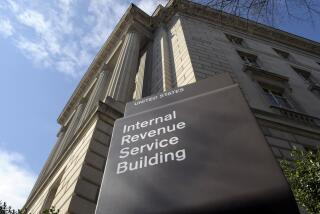Budget Deficit Rises 3% in ’88 to $155 Billion : Administration Points to Overall Downtrend, Smaller Gap Than in ’86
- Share via
WASHINGTON — The federal budget deficit, after dramatically improving last year, grew in fiscal 1988 to $155.1 billion, the Reagan Administration reported Friday.
The Administration’s final accounting for the budget year that ended Sept. 30 showed that the imbalance between revenues and spending rose $5.4 billion, or 3.6%, from the previous year’s $149.7-billion deficit.
But Treasury Secretary Nicholas F. Brady, in a joint statement with the White House Office of Management and Budget, said “the underlying trend in the deficit . . . remains downward.”
The 1988 budget gap, however, was still significantly less than the record of $221.1 billion set in the 1986 fiscal year.
Brady said special factors such as the phase-in of the new tax law in 1987, the sale of the federally owned Conrail freight railroad and a one-day shift of military pay from 1987 into 1988 either shrank the 1987 deficit or inflated the 1988 gap. Excluding the one-time factors, the deficit would have fallen by $31.1 billion between 1987 and 1988, he said.
The federal government spent a record $1.064 trillion during fiscal 1988, up 6% from 1987. Receipts were $909 billion, up 6.4%.
Red ink for the year exceeded the initial Administration projection of $146.7 billion issued in February and the updated estimate of $152.3 billion released in July. It nearly matched the Congressional Budget Office projection of $155 billion.
However, the deficit was well below initial projections of private economists who feared last year that the October stock market crash would slow economic growth, cutting into tax collections and producing a deficit as high as $185 billion.
The Administration said its mid-summer projection was off because it underestimated spending by the Federal Home Loan Bank Board, the agency that rescues insolvent savings institutions. The board spent $8.1 billion in fiscal 1988, $3 billion more than expected.
The board, in a spate of activity from mid-August through the end of September, rescued more than 60 savings and loans. However, much of the spending does not show up on the budget immediately and analysts say assistance to the ailing S&L; industry could contribute $15 billion a year to the deficit over the next three years.
The Administration is predicting it will whittle down the budget deficit for the current fiscal year to $145.5 billion, but most private analysts expect less progress.
The flood of government red ink has been blamed for the nation’s chronic trade imbalance, for holding interest rates above historic averages and for helping to trigger last year’s stock market crash.
More to Read
Get the L.A. Times Politics newsletter
Deeply reported insights into legislation, politics and policy from Sacramento, Washington and beyond. In your inbox twice per week.
You may occasionally receive promotional content from the Los Angeles Times.










